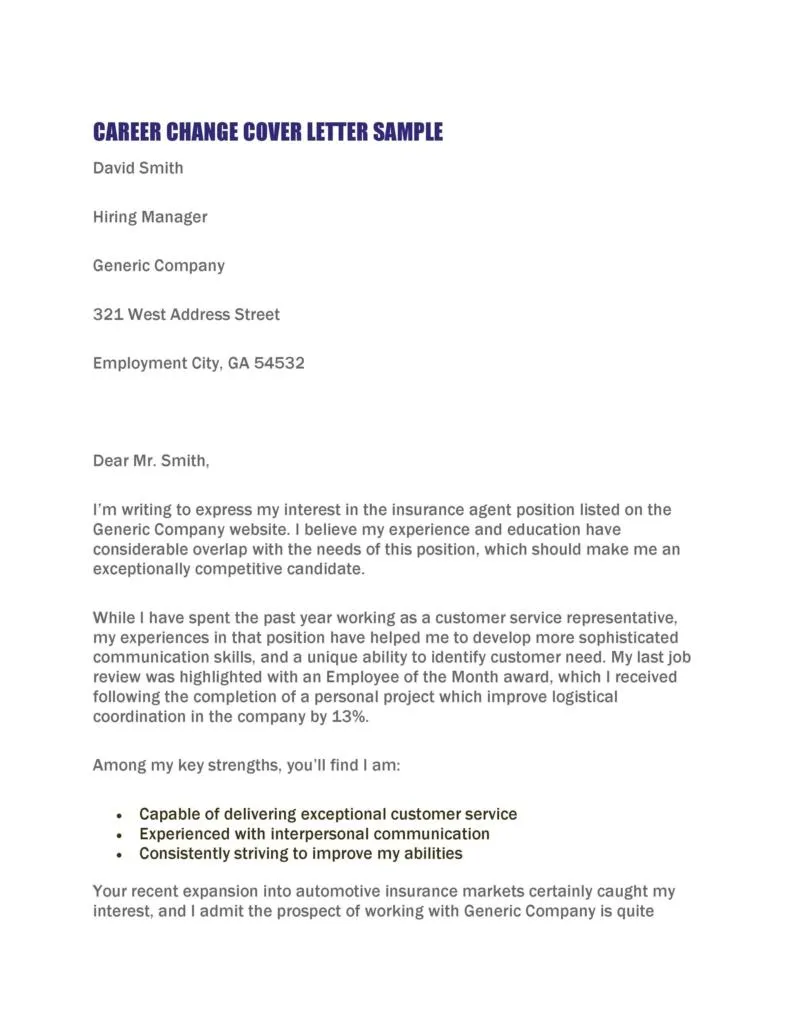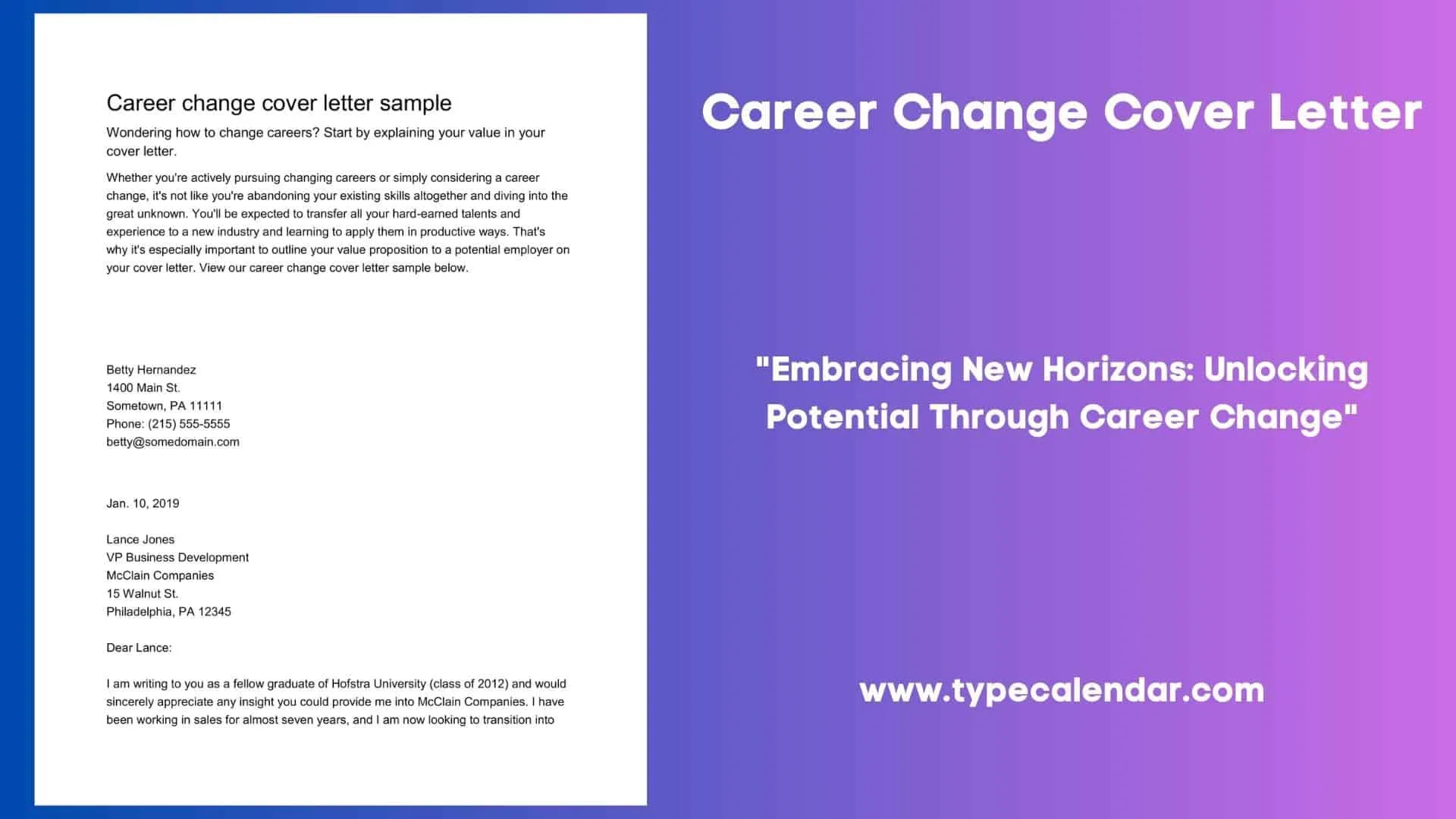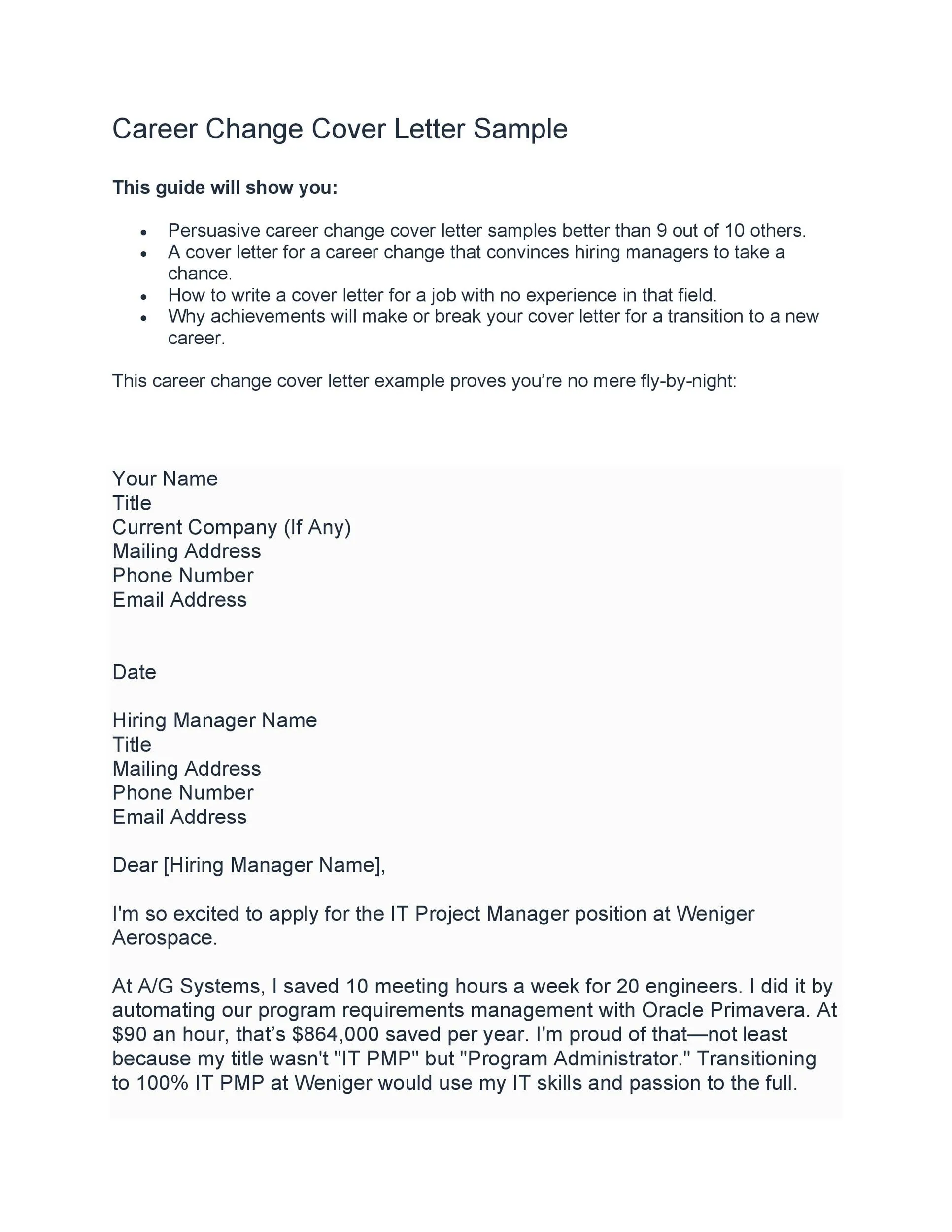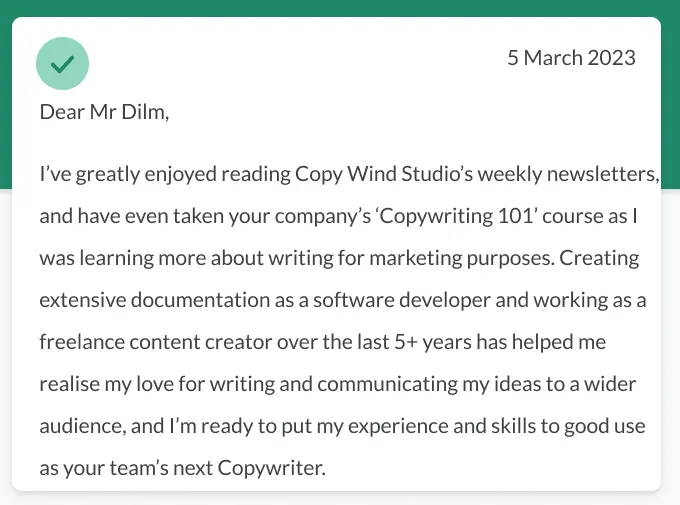Understanding the Importance of a Career Change Cover Letter
Making a career change can be a daunting task, but a well-crafted cover letter can significantly increase your chances of success. When you’re switching fields, your cover letter serves as a critical bridge, connecting your past experiences with your future aspirations. It’s your opportunity to explain your motivations, highlight relevant skills, and demonstrate why you’re a strong candidate despite not having direct experience in the new role. A powerful cover letter makes a strong first impression, setting the stage for the hiring manager to see your potential and consider your application. It’s not just about listing your previous jobs; it’s about telling a compelling story of your career journey and future goals. A well-written cover letter is your personal introduction to the hiring manager, offering an explanation of your career shift and what makes you the ideal candidate. In a competitive job market, a cover letter can differentiate you from other applicants and convince the recruiter to delve into your resume.
Highlighting Transferable Skills
One of the most crucial elements of a career change cover letter is emphasizing your transferable skills. These are the skills you’ve gained in previous roles that are relevant to the new position, even if the industries or specific job functions differ. Identifying and highlighting these skills is essential for bridging the gap between your past experience and the requirements of the new role. Think about skills like communication, problem-solving, project management, leadership, and analytical abilities. These skills are valuable across a multitude of industries and are often the key to making a successful transition. By showcasing how these skills align with the new role, you demonstrate your capability and readiness to perform effectively. The goal is to show how your existing skillset applies to the responsibilities of the role you’re applying for, convincing the recruiter that you are a viable option.
Identifying Key Skills

To effectively highlight your transferable skills, begin by identifying the key skills required for the new role. Carefully review the job description and make a list of the specific skills the employer is seeking. Once you have this list, assess your own skills and experiences to find those that match. It’s important to be specific. Instead of simply stating that you have ‘good communication skills,’ provide examples of how you have used these skills effectively in previous roles. For instance, ‘I have a proven track record of communicating complex information clearly and concisely to diverse audiences, as demonstrated in my role at X company, where I led presentations to stakeholders’. Quantify your accomplishments whenever possible. Using metrics and specific examples makes your claims more credible and memorable. Ensure that you are backing up your claims with evidence of practical experience.
Showcasing Accomplishments
Alongside skills, highlight your accomplishments in previous roles. Focus on what you achieved and the positive impact you had. This demonstrates your ability to deliver results, which is critical when making a career change. Whenever possible, quantify your achievements with numbers, data, and specific examples. Instead of saying you ‘improved customer satisfaction,’ state that you ‘increased customer satisfaction scores by 15% within six months’. This provides concrete evidence of your abilities. Use the STAR method (Situation, Task, Action, Result) to structure your examples. Briefly describe the situation, the task you were assigned, the actions you took, and the results you achieved. This structured approach makes it easy for the hiring manager to understand your contributions. Choose accomplishments that are relevant to the new role and that show you can adapt to new challenges, making the hiring manager more confident in your ability to transition.
Addressing the Career Change Directly
Acknowledge your career change head-on in your cover letter. Don’t shy away from the fact that you are transitioning fields. Instead, address it directly and explain your motivations. This approach demonstrates transparency and initiative. Ignoring the career change can raise questions and doubts in the hiring manager’s mind. Explain your reasons for making the switch. This is your opportunity to tell your story and explain why you’re pursuing a new career path. Be clear, concise, and honest in your explanation. Keep your explanations focused on your goals and aspirations for the new role, rather than complaints about your previous roles. Your cover letter should reflect your enthusiasm, presenting you as a committed candidate with clear aspirations. This will demonstrate your proactive approach to your career goals.
Explaining the Reason for the Switch

Provide a brief and compelling explanation for why you’re making a career change. This could be due to a newfound passion, a desire for growth, or a better alignment with your values. Keep the explanation positive and focused on what you’re seeking in your next role. Avoid negativity about previous roles or employers. Instead, frame your reasons as a proactive step toward your goals. Emphasize the benefits the new role brings to you and how it aligns with your career aspirations. For example, if you’re moving from accounting to marketing, you might highlight your interest in creativity, brand development, and consumer engagement. This clarification showcases your clear motivations, making it easier for the recruiter to understand your aspirations and how you can contribute to the new field. Clear, concise explanations are much more effective than long-winded explanations.
Demonstrating Enthusiasm for the New Field
Show genuine enthusiasm for the new field. Express your excitement about the opportunity to learn and grow in the new role. This can be achieved by demonstrating that you have researched the industry, the company, and the specific role. Mention specific aspects of the job or the company that resonate with you. This indicates that you have a genuine interest in the opportunity. Use language that conveys your passion and excitement. For instance, instead of saying ‘I am interested in this role,’ you could say, ‘I am incredibly enthusiastic about the opportunity to contribute to X company’s mission and further develop my skills’. Highlight specific projects, initiatives, or aspects of the company’s work that you find particularly appealing. Your enthusiasm will help convey your genuine interest and eagerness, which will convince the hiring manager of your suitability.
Tailoring the Cover Letter to the Target Role
Customize your cover letter for each specific job you apply for. A generic cover letter will not be as effective as one tailored to the specific role. Review the job description carefully and highlight the skills, experience, and qualifications that are most relevant to the position. This demonstrates your understanding of the job requirements and your ability to match the employer’s needs. Use the same keywords that are used in the job description to ensure your cover letter aligns with the employer’s needs. Ensure that the language, tone, and content of the cover letter are aligned with the role. Researching the company and the role beforehand will help you customize your cover letter to show that you care about the role and the organization. Tailoring is not about changing your fundamental skills, but about demonstrating that you understand the specific context of the job.
Researching the Company and Role

Before you begin writing your cover letter, research the company and the role. Understand the company’s mission, values, culture, and recent achievements. This information will help you tailor your letter to align with the company’s needs and demonstrate your genuine interest. Visit the company’s website, read news articles, and check social media profiles to gather insights. The more you know, the better you can articulate why you’re a good fit. Study the job description carefully, paying attention to the required skills, experience, and responsibilities. Identify the key areas where your experience aligns with the role. Use the information to highlight your knowledge of the company, your understanding of the role, and your ability to add value. Demonstrating that you have invested time in understanding the company’s mission is always valuable to a hiring manager.
Matching Skills and Experience to the Job Description
Carefully review the job description and match your skills and experience to the requirements. Focus on the key skills and experiences that are explicitly mentioned in the description. Prioritize those skills and experiences when writing your cover letter, providing specific examples of how you have used them in the past. This shows the hiring manager that you have the skills they’re looking for. Use the same keywords and phrases from the job description. This not only helps you match your skills to the role but also helps your application get through applicant tracking systems (ATS). The ATS systems often scan for these keywords to determine if an applicant is a match. Provide concrete examples of how you have used these skills in previous roles, and the results you achieved. This provides evidence of your claims and proves your ability to perform the job. Provide examples which show your capability and suitability for the new role.
Formatting and Tone for Impact
The formatting and tone of your cover letter play a crucial role in making a powerful first impression. Formatting and tone can influence how the hiring manager views you, shaping your chances of progressing in the application process. A well-formatted and professionally-toned cover letter demonstrates attention to detail and professionalism. The appearance, readability, and tone should be carefully chosen to ensure a positive reception and to highlight your best qualities as a potential employee. Good formatting and an appropriate tone can create a favorable impression even before the reader absorbs the content. The letter should be easy to read, well-structured, and communicate a positive, professional image. Use a clean and modern font, maintain consistent spacing, and ensure that the letter is easy to read.
Choosing the Right Tone

Choose a tone that is professional, enthusiastic, and confident. Your tone should reflect your personality and the values of the company you’re applying to. While enthusiasm is important, avoid sounding overly casual or informal. Maintain a balance between professionalism and personality. Use a positive and proactive tone throughout your cover letter. Frame your career change as a positive step toward your career goals. Use action verbs to demonstrate your accomplishments and emphasize your skills. This adds strength and impact to your writing. Adjust your tone to match the company’s culture and the specific requirements of the role. Research the company and try to get a sense of their communication style and adapt your tone accordingly. Your letter should display your competence and your genuine interest in the role.
Formatting for Readability
Formatting for readability is crucial for ensuring your cover letter is easy to read and understand. Use a clean and modern font like Arial, Times New Roman, or Calibri. Keep the font size between 10 and 12 points. Make sure your font is readable and looks professional. Use consistent spacing between lines, paragraphs, and sections. A well-spaced document is easier on the eyes and more visually appealing. Use clear headings and bullet points to organize your information. Break your text into short, concise paragraphs. This helps the reader to quickly grasp the key points. Avoid using excessive bolding, underlining, or italics, as they can make the document look cluttered. Ensure that your layout is consistent throughout your letter. A well-formatted cover letter projects professionalism and attention to detail, which are essential in any job application. The objective is to make the reader easily scan and digest your information.
Proofreading and Editing for Perfection
Proofreading and editing are essential for ensuring your cover letter is polished and error-free. Errors can undermine your credibility and give the impression that you lack attention to detail. Always proofread your cover letter carefully, checking for spelling, grammar, punctuation, and syntax errors. Errors make your cover letter look unprofessional. Use a spell checker and grammar checker, but also read your cover letter aloud to catch any mistakes that these tools may miss. Consider asking a friend, family member, or career advisor to review your cover letter. A fresh pair of eyes can often spot errors that you may miss. Ensuring a flawless cover letter is a great way to impress the hiring manager. A well-proofread letter shows respect for the reader and a commitment to excellence. Taking the time to refine your cover letter can significantly improve your chances of landing an interview.
In conclusion, crafting a powerful cover letter is critical for anyone making a career change. By understanding its importance, highlighting transferable skills, addressing the career change directly, tailoring the letter to each role, and ensuring a professional format, you will significantly increase your chances of making a lasting impression. Remember to always proofread, edit, and express genuine enthusiasm. A well-crafted cover letter isn’t just a formality; it’s your opportunity to tell your story and showcase your potential in a new field. Your cover letter can transform your career switch from a challenge to an exciting opportunity.
